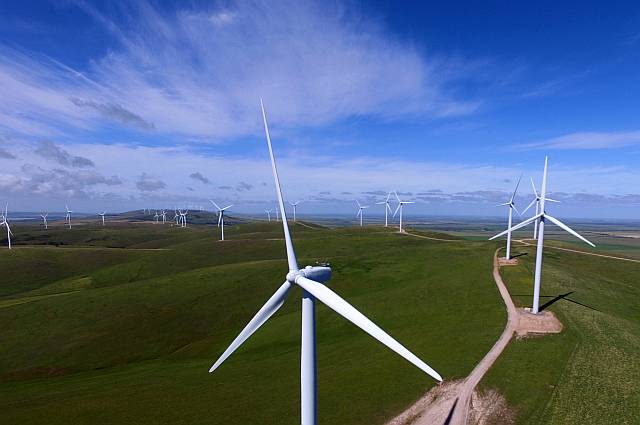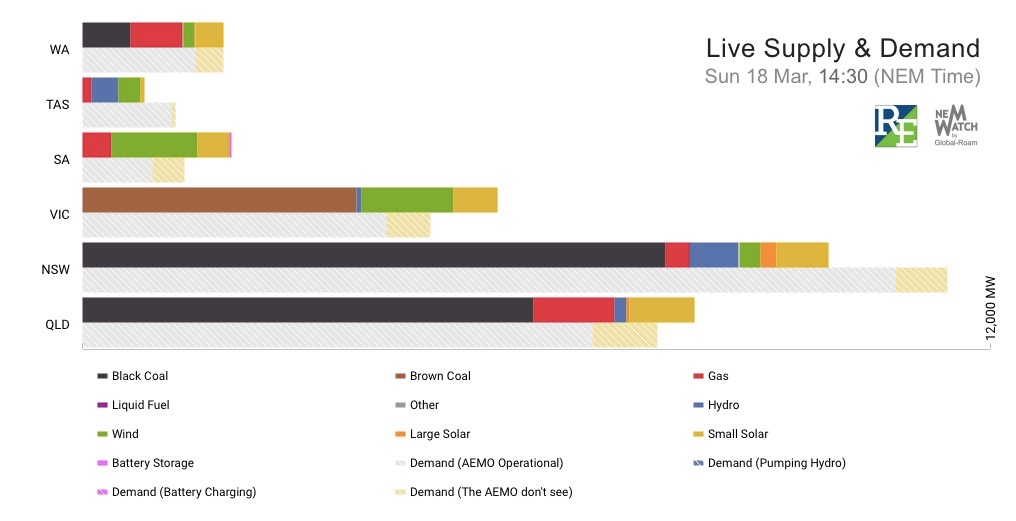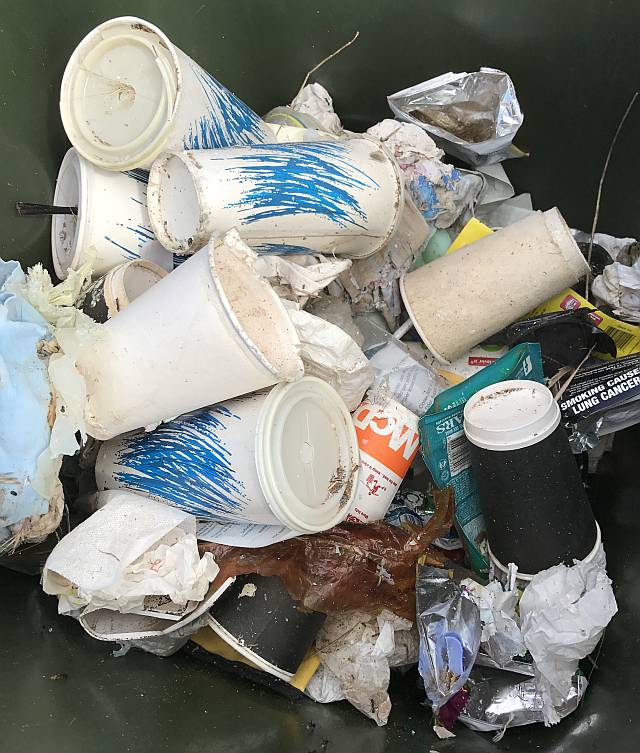| |
South Australia's Snowtown Wind Farm
|
|---|

| The most productive wind farm in Australia in 2017
|
|
|
|
|
Electricity generation and demand in Australia
|
|---|

| |
| |
I write this on 2018/05/05.
Tomorrow will be 50 days from the election of 2018/03/17 that brought the Marshall Government to power in South Australia.
The Marshall Government seems to have done or decided very little in this period.
I looked up ourenergyplan.sa.gov.au to see what they had decided, I found Jay Whetherill's photo on the pdf file.
It seemed that the Marshall Government had changed nothing on that site.
Proposed interconnected with NSW
Before the March 2018 election that made him Premier Steven Marshall had proposed building a new electricity interconnector between SA and NSW with the stated aim of giving SA access to reliable coal-fired
base-load power.
There are several factors in this that Mr Marshall may not have recognised:
-
SA does not need base load power, all states from time to time could use more
peaking power;
-
Peaking power could come via an interstate interconnector or it could be generated locally by
pumped hydro or
batteries;
-
An additional interconnector will encourage renewable energy development in SA.
At present the existing interconnectors are sometimes running at full capacity exporting renewable energy to the eastern (mainly coal-powered) states.
At these times generation from wind farms may need to be curtailed.
Increased interconnector capacity will make SA a more attractive place to build renewable energy installations by reducing the need for curtailment.
-
The interconnector could take up to nine years to plan and build, and could cost far more than Premier Marshall's estimated $200 million (by October 2020 the cost estimate had reached $2.4 billion).
| |
An article in The Guardian, by Max Opray, on 2018/03/20, was very pessimistic about the future of renewable power in SA with the election of the Marshall government.
Marshall had promised to repeal SA's renewable energy target and hod opposed the closure of the state's last coal-fired power stations.
|
|
The graph above on the right was recorded on the day after the election that brought the Marshall government to power.
It shows that SA was, at the time, exporting a lot of power (the coloured bar showing SA's generation was much longer than the paler bar that showed SA's consumption – the difference was the amount of power being exported).
It also shows that about 80% of SA's power at the time was wind (green) and solar (yellow).
Comment, 2021/02/04
Premier Marshall might have been surprised to gradually come to the realisation that his proposed interconnector would do far more to help renewables than to prop up the
dying coal industry that the Australian Liberals have long supported.
Far from being used to import coal-fired power into SA, by early 2021 it was clear that the interconnector would be a great boon for the state's renewable energy. It would open up far more of the eastern Australian market to renewable energy generated in SA.
|
| |
|
This section added 2019/05/12
|
|
After more than a year in power not one new wind farm had been approved, construction of the several proposed and much needed pumped hydro schemes had not started, and, so far as I knew, no new major solar farm had been approved.
| |
This section added
2021/07/06
|
|
| |
|
Personal interest
I have met Minister Pellekaan once or twice and corresponded with him due to my interest in renewable energy.
In the scheduled 2022 election Dan will be competing against independent MP Geoff Brock for the seat of Stuart, where I live, due to an electoral boundary change. I like both of them; only one con go on to the next term of parliament.
|
|
Minister Pellekaan rejected a Freedom of Information application from Senator Rex Patrick and Frank Pangallo MLC (of SA-BEST). The two made a joint application for communication information between the State and Federal Government.
According to Senator Patrick Minister van Holst Pellekaan refused to process the application because of the fact that the two politicians made the applications together.
This seems quite unreasonable.
See Senator Patrick's Facebook page for more information.
| |
|
Renewables are the cheapest
By late 2020 it had been recognised internationally that renewable energy (solar PV and on-shore wind in particular) were the cheapest forms of electricity generation.
|
|
Giles Parkinson reported on
RenewEconomy, 2018/03/20, that – contrary to claims made by Premier Marshall – SA may not have the most expensive power in Australia, wholesale power prices were slightly higher in Victoria in the second half of 2017, and in the last quarter of 2017 SA exported more renewable energy to Victoria than it imported coal-fired power.
This is a taste of things to come as more wind farms and solar power stations come on-line.
No doubt Premier Marshall will claim credit for decreasing power prices and increasing power exports to the eastern states in the future, while the process was in place before he came to power.
The South Australian Rann Labor Government (2002-2011) and the following Weatherill Government (2011-2018) have received quite a bit of credit for the state's adoption of renewable energy, and it is true that unlike a number of other state and federal governments, they didn't oppose the development of renewable energy.
| |
|
|
|---|

| I picked up this lot of rubbish on Gadd Avenue, just outside of Crystal Brook, 2017/03/07. Note the high proportion of throw-away cups. (I've written more on my efforts at cleaning up rubbish elsewhere on this site.)
While the Marshall government banned the sale of some single use plastics in March 2021, and is to ban more as of sometime in 2022, I have not seen any indication that they will ban single use cups. | |
But the fact that the Weatherill Government encouraged fracking in South Eastern South Australia and supported the investigation of the possibility of in-situ coal gasification (ISCG) in the Leigh Creek area suggest that the Weatherill Government at least may have been opportunistic rather than ethical.
It is noteworthy that the Liberal-National coalition Marshal Government passed a bill legislating a moratorium on fracking in the South East of South Australia in October 2018.
Louise Horobin wrote an
article in the Border Chronicle, 2018/10/26.
She wrote "Limestone Coast Protection Alliance chairperson Angus Ralton congratulated the community and local politicians for continuing to fight for legislation reform."
Mr Ralton was quoted as saying:
“This is a well deserved outcome for the community that has fought so hard.
Thanks must go to our local independent MP, Troy Bell for moving this Bill and to Nick McBride for getting the Libs on board.
We'd also like to thank Mark Parnell and fellow Greens in the Upper House as well as SA Best whose support was crucial in getting this Bill through.”
There can be no doubt at all that the federal Liberal-National coalition governments of Prime Ministers Abbott,
Turnbull and Morrison were anti-environment and pro-coal.
The federal Labor Opposition has generally been more environmentally responsible, although they want to support the coal mining industry at the same time; an impossible balancing act.
It would seem that the situation in South Australia is more open to question. It remains to be seen whether the Marshall Government will allow the shockingly polluting proposed
in-situ gasification of coal proposed for Leigh Creek to go ahead.
| |
This section added
2021/02/04
|
|
This has to be a "seeing the light" moment comparable to Saul/St Paul on the road to Damascus
The South Australian Liberals under Steven Marshall and other leaders has undergone a remarkable change, one might say an enlightenment, in the eight years from 2013 to 2021.
In 2013 I wrote a page about David Ridgway's dishonest, pig-headed and foolish opposition to wind power. At that time Mr Ridgway was the leader of the Liberal opposition in the SA Legislative Council.
By late 2020 the Marshall government was talking up the huge potential future that South Australia has in the further development of renewable energy.
Indeed, the Marshall government announced a target of 500% renewable energy by 2050.
At the time of writing there were two other Australian states that had Liberal/Coalition governments: NSW under Premier Gladys Berejiklian and Tasmania under Peter Gutwein. Again, at the time of writing, both had seen that the
future was with sustainability, both were strongly supportive of renewable energy. How long must we wait for our federal Morrison government to 'see the light'?
(I have written a page on SA's energy future elsewhere on this site.)
| |
This section added
2021/02/17
|
|
In an article in
The Driven written by Giles Parkinson and published 2020/12/20 it was reported that:
"The South Australia state government says it wants to lead Australia in the uptake of electric vehicles, and is aiming to ensure that all new car sales in the state are fully electric by 2035..."
The turn-around in the people who make up this government over the past ten or so years continues to amaze.
| |
This section added
2021/02/04
|
|
In early February 2021 I received an email from and organisation calling itself
Advocates for the SA Outback.
The group - of conservationists, scientists and concerned citizens - were raising awareness of proposed changes to the Pastoral Land Management and Conservation Act of 1989. Their main concern was that the proposed changes would allow overstocking in the state's pastoral lands, which they rightly stated would be disastrous.
They had a number of concerns with the proposed changes. Quoting the email I received:
"The proposed new Bill stacks the 6-member Pastoral Board with five pastoralists, removes scientific positions (ecologist, soil scientist) and the Conservation Council representative) as required under the current 1989 Act. An 'industry-captured' board will automatically renew 100-year leases, creating effective freehold. Stocking limits are to be abandoned. Tourism access to the pastoral lands will be more difficult. Effective on-ground environmental assessments will no longer need to be ’thorough’ as required under the 1989 Act, and will be replaced with unproven remote-sensing techniques. Biodiversity conservation will no longer be an objective, and the new Board will likely oppose the establishment of new biodiversity reserves on pastoral leases."
The changes seem to me to have potentially very bad environmental consequences and need to be opposed. I signed the petition opposing the changes.
I've written to two local politicians about my concerns.


